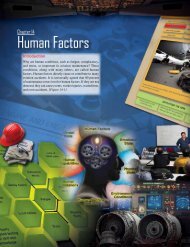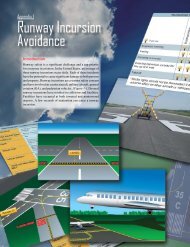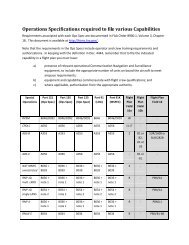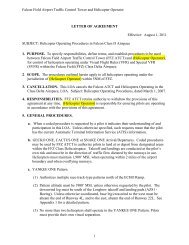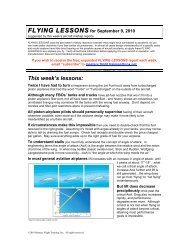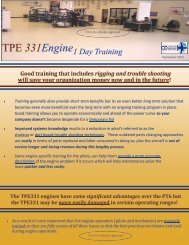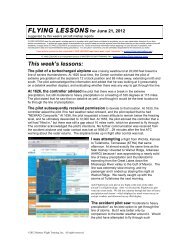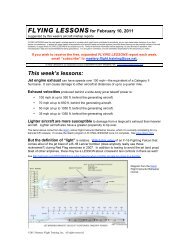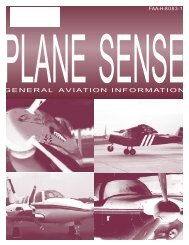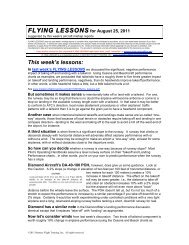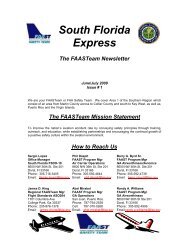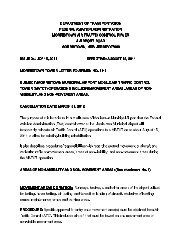SPATIAL DISORIENTATION: - FAA
SPATIAL DISORIENTATION: - FAA
SPATIAL DISORIENTATION: - FAA
Create successful ePaper yourself
Turn your PDF publications into a flip-book with our unique Google optimized e-Paper software.
<strong>SPATIAL</strong> <strong>DISORIENTATION</strong>:Seeing Is Not BelievingSpatial OrientationSpatial orientation defines our natural ability to maintain our body orientationand/or posture in relation to the surrounding environment (physical space) at restand during motion. Genetically speaking, humans are designed to maintain spatialorientation on the ground. The flight environment is hostile and unfamiliar to thehuman body; it creates sensory conflicts and illusions that make spatial orientationdifficult, and, in some cases, even impossible to achieve. Statistics show that between5 to 10% of all general aviation accidents can be attributed to spatial disorientation,and 90% of these accidents are fatal.Spatial Orientation on the GroundGood spatial orientation on the ground relieson the effective perception, integration,and interpretation of visual, vestibular (organsof equilibrium located in the inner ear), andproprioceptive (receptors located in the skin,muscles, tendons, and joints) sensory information.Changes in linear acceleration, angular acceleration,and gravity are detected by the vestibularsystem and the proprioceptive receptors,and then compared in the brain with visual information(Figure 1).Figure 1Spatial Orientation In FlightSpatial orientation in flight is sometimes difficult to achieve because the varioustypes of sensory stimuli (visual, vestibular, and proprioceptive) vary in magnitude,direction, and frequency. Any differences or discrepancies between visual, vestibular,and proprioceptive sensory inputs result in a “sensory mismatch” that can produceillusions and lead to spatial disorientation.Vision and Spatial OrientationVisual references provide the most important sensory information to maintainspatial orientation on the ground and during flight, especially when the body and/orthe environment are in motion. Even birds, reputable flyers, are unable to maintainspatial orientation and fly safely when deprived of vision (due to clouds or fog).Only bats have developed the ability to fly without vision but have replaced theirvision with auditory echolocation. So, it should not be any surprise to us that, whenwe fly under conditions of limited visibility, we have problems maintaining spatialorientation.
Central VisionCentral vision, also known as foveal vision is involved with the identification ofobjects and the perception of colors. During instrument flight rules (IFR) flights,central vision allows pilots to acquire information from the flight instruments thatis processed by the brain to provide orientational information. During visual flightrules (VFR) flights, central vision allows pilots to acquire external information (monocularand binocular) to make judgments of distance, speed, and depth.Peripheral VisionPeripheral vision, also known as ambient vision, is involved with the perceptionof movement (self and surrounding environment) and provides peripheral referencecues to maintain spatial orientation. This capability enables orientation independentfrom central vision and that is why we can walk while reading. With peripheral vision,motion of the surrounding environment produces a perception of self-motioneven if we are standing or sitting still.Visual ReferencesVisual references that provide information about distance, speed, and depth ofvisualized objects include:• Comparative size of known objects at different distances.• Comparative form or shape of known objects at different distances.• Relative velocity of images moving across the retina. Nearby objects are perceivedas moving faster than distant objects .• Interposition of known objects. One object placed in front of another is perceivedas being closer to the observer.• Varying texture or contrast of known objects at different distances. Object detailand contrast are lost with distance.• Differences in illumination perspective of objects due to light and shadows.• Differences in aerial perspective of visualized objects. More distant objects are seenas bluish and blurry.The flight attitude of an airplane is generally determined by the pilot’s visualreference to the natural horizon. When the natural horizon is obscured, attitude cansometimes be maintained by visual reference to the surface below. If neither horizonnor surface visual references exist, the airplane’s attitude can only be determined byartificial means such as an attitude indicator or other flight instruments. Surface referencesor the natural horizon may at times become obscured by smoke, fog, smog,haze, dust, ice particles, or other phenomena, although visibility may be above VFRminimums. This is especially true at airports located adjacent to large bodies of wateror sparsely populated areas, where few, if any, surface references are available. Lackof horizon or surface reference is common on over-water flights, at night, or in lowvisibility conditions.Visual IllusionsVisual illusions are familiar to most of us. As children, we learned that railroad tracks—contrary to what our eyes showed us— don’t come to a point at the horizon. Evenunder conditions of good visibility, you can experience visual illusions including:Aerial Perspective Illusions may make you change (increase or decrease) the slopeof your final approach. They are caused by runways with different widths, upslopingor downsloping runways, and upsloping or downsloping final approach terrain. Pilotslearn to recognize a normal final approach by developing and recalling a mentalimage of the expected relationship between the length and the width of an averagerunway (Figure 2).Figure 2A final approach over a flat terrain with an upsloping runway may produce thevisual illusion of a high-altitude final approach. If you believe this illusion, you mayrespond by pitching the aircraft nose down to decrease the altitude, which, if performedtoo close to the ground, may result in an accident (Figure 3).Figure 3A final approach over a flat terrain with a downsloping runway may produce thevisual illusion of a low-altitude final approach. If you believe this illusion, you mayrespond by pitching the aircraft nose up to increase the altitude, which may result ina low-altitude stall or a missed approach (Figure 4).Figure 4
A final approach over an upsloping terrain with a flat runway may produce thevisual illusion of a low-altitude final approach. If you believe this illusion, you mayrespond by pitching the aircraft nose up to increase the altitude, which may result ina low-altitude stall or a missed approach (Figure 5).Figure 8Figure 5A final approach over a downsloping terrain with a flat runway may produce thevisual illusion of a high-altitude final approach. If you believe this illusion, you mayrespond by pitching the aircraft nose down to decrease the altitude, which, if performedtoo close to the ground, may result in an accident (Figure 6).A Black-Hole Approach Illusion can happen during a final approach at night(no stars or moonlight) over water or unlighted terrain to a lighted runway beyondwhich the horizon is not visible. In the example (Figure 9), when peripheral visualcues are not available to help you orient yourself relative to the earth, you mayFigure 6A final approach to an unusually narrow runway or an unusually long runwaymay produce the visual illusion of a high-altitude final approach. If you believe thisillusion, you may respond by pitching the aircraft nose down to decrease the altitude,which, if performed too close to the ground may result in an accident (Figure 7).Figure 9Figure 10have the illusion of being upright and may perceive the runway to be tilted left andupsloping. However, with the horizon visible (Figure 10), you can easily orient yourselfcorrectly using your central vision.A particularly hazardous black-hole illusion involves approaching a runway underconditions with no lights before the runway and with city lights or rising terrainbeyond the runway. These conditions may produce the visual illusion of a highaltitudefinal approach. If you believe this illusion, you may respnd by lowering yourapproach slope (Figure 11).Figure 7A final approach to an unusually wide runway may produce the visual illusion of alow-altitude final approach. If you believe this illusion, you may respond by pitchingthe aircraft nose up to increase the altitude, which may result in a low-altitude stallor a missed approach(Figure 8).Figure 11
The Autokinetic Illusion gives you the impression that a stationary object is movingin front of the airplane’s path; it is caused by staring at a fixed single point of light(ground light or a star) in a totally dark and featureless background. This illusioncan cause a misperception that such a light is on a collision course with your aircraft(Figure 12).Figure 13Figure 12False Visual Reference Illusions may cause you to orient your aircraft in relationto a false horizon; these illusions are caused by flying over a banked cloud, night flyingover featureless terrain with ground lights that are indistinguishable from a darksky with stars, or night flying over a featureless terrain with a clearly defined patternof ground lights and a dark, starless sky (Figure 13).Vection Illusion: A common example is when you are stopped at a traffic light inyour car and the car next to you edges forward. Your brain interprets this peripheralvisual information as though you are moving backwards and makes you apply additionalpressure to the brakes. A similar illusion can happen while taxiing an aircraft.How to Prevent Spatial Disorientation• Take the opportunity to personally experience sensory illusions in a Barany chair,a Vertigon, a GYRO, or a Virtual Reality Spatial Disorientation Demonstrator(VRSDD). By experiencing sensory illusions first hand (on the ground), pilots arebetter prepared to recognize a sensory illusion when it happens during flight andto take immediate action. The Aeromedical Education Division of the <strong>FAA</strong> CivilAerospace Medical Institute offers spatial disorientation demonstrations with theGYRO and the VRSDD in Oklahoma City and at all of the major airshows in thecontinental U.S.• Obtain training and maintain your proficiency in aircraft control by reference toinstruments.• When flying at night or in reduced visibility, use and rely on your flight instruments.• Study and become familiar with unique geographical conditions where flight isintended.• Do not attempt visual flight when there is a possibility of being trapped in deterioratingweather.• If you experience a visual illusion during flight (most pilots do at one time or another),have confidence in your instruments and ignore all conflicting signals yourbody gives you. Accidents usually happen as a result of a pilot’s indecision to rely onthe instruments.• If you are one of two pilots in an aircraft and you begin to experience a visual illusion,transfer control of the aircraft to the other pilot, since pilots seldom experiencevisual illusions at the same time.• By being knowledgeable, relying on experience, and trusting your instruments,you will be contributing to keeping the skies safe for everyone.
Medical Facts for PilotsPublication AAM-400-00/1Revised by: Melchor J. Antuñano, M.D.Prepared byFederal Aviation AdministrationCivil Aerospace Medical InstituteAerospace Medical Education DivisionPhysiologicalTraining Classes—free training thatcould save your life!To request copies of this brochure and others listed below, contact<strong>FAA</strong> Civil Aerospace Medical InstituteShipping Clerk, AAM-400P.O. Box 25082Oklahoma City, OK 73125(405) 954-4831Other Pilot Safety Brochures AvailableNumber TitleAM-400-94/2 Alcohol and Flying: A Deadly CombinationAM-400-95/2 Altitude Decompression SicknessOK05-0270 Carbon Monoxide: A Deadly ThreatAM-400-03/2 Deep Vein Thrombosis and TravelAM-400-98/3 Hearing and Noise in AviationAM-400-97/1 Introduction to Human Factors in AviationOK05-0005 Medications and FlyingAM-400-01/1 Physiological Training Courses for Civil Aviation PilotsAM-400-98/2 Pilot VisionAM-400-91/2 Seat Belts and Shoulder HarnessesAM-400-95/1 Smoke!AM-400-03/1 Spatial Disorientation: Why You Shouldn’t Fly By the Seat of Your PantsAM-400-05/1 Sunglasses for Pilots: Beyond the ImageTo view these pilot and passenger safety brochures, visit the Federal Aviation Administration’sWeb Sitewww.faa.gov/pilots/safety/pilotsafetybrochures/Physiological Training Classes for PilotsIf you are interested in taking a one-day aviation physiological training coursewith altitude chamber and vertigo demonstrations or a one-day survival course, learnabout how to sign up for these courses that are offered at 14 locations across the U.S.by visiting this <strong>FAA</strong> Web site:www.faa.gov/pilots/training/airman_education/aerospace_physiology/index.cfmSpatial Disorientation (Vertigo)Demonstrators. Above: GYRO-2General Aviation Trainer.Right: Virtual Reality DisorientationDemonstrator.Altitude chamber training at the Civil Aerospace Medical Institute inOklahoma City, Oklahoma.




